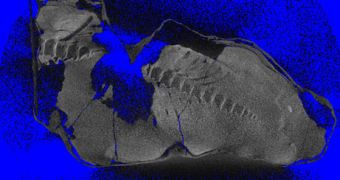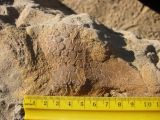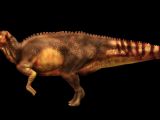Mummies can go far beyond the era of the ancient pharaohs. Even to the dinosaur era. Researchers have just revealed the discovery of an amazingly preserved "dinosaur mummy", containing a lot of tissues and bones inside skin wrapping, including well preserved tendons and ligaments, which are seldom discovered nowadays, when most dinosaur remains that are found are only scattered bones.
The discovery of the 67-million-year-old duck-billed dinosaur has already changed concepts regarding how the dinosaurs' skin looked like and how rapid they were.
"We're looking at a 3-D skin envelope. In many places it's complete and intact-around the tail, arms, and legs and part of the body", excavation leader Phillip Manning, a paleontologist at Britain's University of Manchester and a National Geographic Expeditions Council grantee, told National Geographic.
The duck-billed dinosaur was found in 1999 by the then teenage paleontologist Tyler Lyson (now, a graduate student in geology at Yale University in New Haven, Connecticut), on the property of his family in North Dakota.
The discovery of a mummified dinosaur is a really lucky event, as the dinosaur body hasn't been consumed by predators or scavengers and exposed to rapid rotting conditions. So, the tissues must have been mineralized before bacteria entered into the action. Moreover, the remains must have remained intact for many millions of years.
"Plant-eating duck billed dinosaurs had horny, toothless beaks but hundreds of teeth in their cheeks and a long, stiff tail that was likely used for balance." said Manning.
The mummified dinosaur was about 35 ft (12 m) long and weighed some 35 tons (as much as 7 African elephants), but CT scanning determined that the muscle mass located between the bone and skin tail was 25 % larger than it had previously been thought. Based on this information, a computer model determined the speed of the huge beast.
"A more muscular rear end means more powerful legs. Our models confirm this duck-billed dinosaur would have had potential to run faster than T. rex," Manning said.
The mummified dinosaur could have run with 28 mi (45 km) per hour, while Tyrannosaurus rex with just 20 mi (32 km) per hour (anyhow, this is faster than a human). Indeed, duck-billed dinosaurs were preyed by T. rex, and as they did not have horns or armors, speed was their prime defense.
The mummified skin has lost its color, but not its texture, and 3-D mapping could reveal the way its lifetime has been.
"There seems to be a variation in scale size that might possibly correlate-as it does in modern reptiles in many cases-with changes in color. There seems to be striping patternations associated with joint areas on the arm, and there's interesting information we're looking at in the tail as well." said Manning.
Complete specific findings will be revealed for the public in a scientific journal.

 14 DAY TRIAL //
14 DAY TRIAL // 

